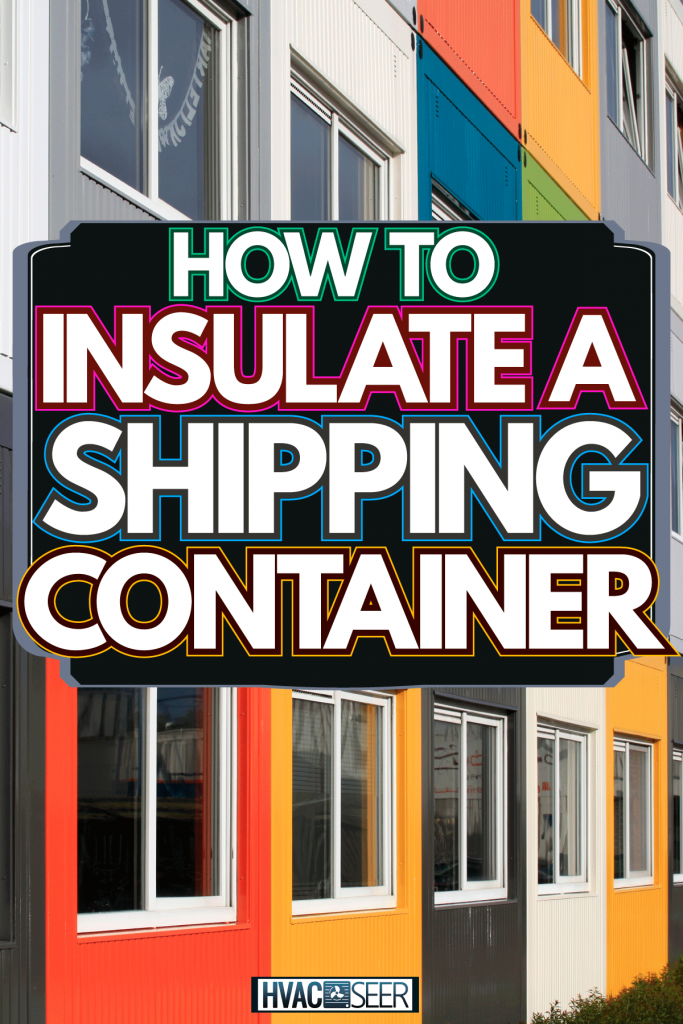Public storage and shipping containers are increasing in popularity as people look for extra spaces to house personal items. But how do you insulate a shipping container? We have done a bit of research on shipping containers and the best materials to insulate them. In this post, we will go over them.
There are quite a few ways that you can insulate a shipping container. The most popular and effective ones include:
- Batts/Rolls
- Blow-in (aka "Loose-fill") Rigid Foam Board
- Reflective Barriers
- Hempcrete or Strawbale
- Denim Insulation
- Mineral Wool
- Cork Insulation

Insulating Materials For Shipping Containers
Insulating your shipping container can help regulate the internal temperature of the unit. It can also help prevent condensation and mold from developing on your personal items or other furniture stored in the container.

Fiberglass Batts/Rolls
This is typically the most common type of insulation used in shipping containers. It's one of the cheapest options available, and it's readily available both online and in local hardware stores. It's also super easy to install.
Fiberglass batts and rolls are similar to warm blankets in that they are thick, fluffy, and effective for keeping out cold air and maintaining internal interior temperatures. Fiberglass batts and rolls can be cut and placed along the ceiling and walls of the shipping container. You can also use staples or nails to hold them in place.
There are many types of batt and roll insulation available, including fiberglass, slag wool, rock wool, and sheep wool.
Find this insulation on Amazon.
Blow-in [aka "Loose-fill"]
Blow-in insulation can also be used to fill the container's wall cavity to help regulate the temperature inside of it. This type of loose-fill insulation material usually includes cellulose, fiberglass, and vermiculite.
Blow-in insulation is installed using a machine that blows the insulation onto the walls and ceiling of the shipping container. The thickness of the insulation will vary depending on how much you use [or the required R-value for the container].
It can be a bit messy, so it's best to use this insulation when creating a workspace or some other area that another wall or structure will cover. This way, the insulation won't be visible, and you don't have to worry about it sagging and running onto the floor as it ages. There are two types of blow-in insulation, open-cell, and closed-cell.
- Closed-cell is the most popular shipping container insulation, and it has one of the highest R-values per inch--and acts as a great vapor retarder. However, suppose you plan to inhabit the space or use it as an office. In that case, you'll want to inquire with the insulation manufacturers about how long it takes to cure, as off-gassing can be an issue with this specific type of blow-in insulation.
- Open-cell: You can also opt for open-cell blow-in insulation. This is a lesser popular type of polyurethane foam insulation, but it can also work for shipping containers. It has a lower R-value per inch and is generally less expensive due to this reason.
Rigid Foam Board
Another easy DIY insulation to consider is rigid foam board. These boards are rigid panels made of polyurethane or polyisocyanurate. They are particularly effective in insulating the walls and ceiling of shipping containers, and they only cost about 10-15% more than fiberglass batts and rolls.
They're installed by simply cutting them [if needed] and then applying them to the wall using a staple gun, adhesive, or mylar tape, you can install the boards yourself.
These boards are typically around 2 to 3 inches thick and will have an R-value of anywhere from 5 to 12.
Find this staple gun on Amazon.
Reflective Barriers
Reflective barrier insulation is also an excellent material to include in a shipping container. It's applied by simply cutting it to size and then stapling, nailing, or using adhesive to attach it to the container's walls and ceilings.
Though it's typically only as thick as a sheet of aluminum foil, it can also come with fiberglass or mineral wool backing for extra insulating properties [which can be anywhere from 1 to 3 inches thick].
This type of insulation is particularly effective in areas where sunlight may be a factor, as it works as a great reflector. Even if you can cover the shipping container with large mylar blankets, it can help reduce the amount of heat that the container absorbs.
Find this insulation on Amazon.
Hempcrete
Both hempcrete and strawbale can be used to insulate a shipping container. Hemp is a bio-composite material made of lime, hemp, and sand. It's commonly used for building construction and is a very lightweight insulating material that can be useful in various climates.
It's also helpful for regulating moisture, meaning that it's good for preventing condensation in shipping containers. It can be applied by cutting the blocks to size and creating a wood frame to stack them on the container's walls.
Denim Insulation
You may not hear of denim insulation as much as other materials, but it's effective for insulating shipping containers. However, its major drawback is its cost, as it's typically about 15-20% more expensive than other materials such as fiberglass and cellulose.
However, denim insulation typically comes in rolls or batts and can be easily installed by simply cutting it to size and lining it up along the walls and ceiling of the container, and it helps if you build wooden frames to help hold the blocks in place [they're often packed tightly against one another].
Mineral Wool
Mineral wool is a type of fiber insulation similar to fiberglass but made from natural materials. It can be installed the same way as denim insulation, by simply cutting the blocks and lining them up along the container's walls and ceiling.
There are two types of mineral wool are available for shipping container insulation: rock wool, which is made from fibers from stone, and slag wool, which is made from fibers from iron ore.
Mineral wool can retain moisture and maintain its insulation properties even when wet. If you have a shipping container that may be prone to fire, mineral wool can be particularly effective as it's resistant to temperatures up to 1800 degrees.
One drawback to mineral wool is its price. However, it comes in many forms and can be about 10% more than your typical fiberglass insulation.
Cork Insulation
Another environmentally-friendly insulation option for shipping containers is cork, a biodegradable and renewable insulation material. Cork also has excellent acoustic qualities, which can be beneficial if using the supply container as a home or workspace.
Cork insulation typically comes in batts about 2-4 inches thick and anywhere from 2-4 feet long. It can be applied by cutting the boards to size and using fasteners or adhesive to attach them to the walls and ceiling of a container.
Want to see how it's done? Check out this video:
What is the R-value for a shipping container?
The R-value for a shipping container will vary, as it depends on the materials of which the container is composed. Most shipping containers are made from steel which has a relatively low R-value. The R-value of steel is below .1.
Why so low? It's simple, steel is an excellent conductor of heat and thermal energy-it's not effective at keeping cold air out and warm air in due to its conductivity. Steel easily allows both cold or warm temperatures to pass through it, which means that it's not an ideal insulation material, even outside the fact that it is considerably heavy.
Can you use fiberglass insulation in a shipping container?

Yes. You can use fiberglass insulation in a shipping container. You can choose from rolls, batts, or loose-fill insulation. The great thing about fiberglass insulation is that it's one of the cheapest options available, it's easy to install, and it's available and several different R-values.
How much does it cost to spray insulate a shipping container?
The cost to spray insulate a shipping container will depend on the type of insulating material that you use. It'll also largely depend on the size of the shipping container. Most shipping containers range anywhere from 10 to 40 feet in length.
If you use fiberglass or cellulose, you'll likely pay anywhere from $1,500 to $8,500, depending on the length of the shipping container. And, of course, you can always save yourself this additional cost by simply installing the insulation yourself. You'll need to rent or purchase an installation machine, however.
How do you keep a shipping container from sweating?

The best way to keep a shipping container from sweating is to insulate it with quality materials such as fiberglass, cellulose, mineral wool, or rockwool. If you don't want to insulate it, you can place a humidifier or a moisture-reducing material inside the container. Common things to use include charcoal brisket, cat litter, or desiccant packs.
Find these desiccant packs on Amazon.
Wrapping things up

We hope this post has helped illustrate a few different ways to insulate a shipping container. Remember, the best insulation material will depend on your specific shipping container and the region in which it's located. It's also best to consider what will be placed inside the container, as some insulation materials will take up more space than others while providing the same level of insulation.
Before you go, be sure to check out our other posts:




